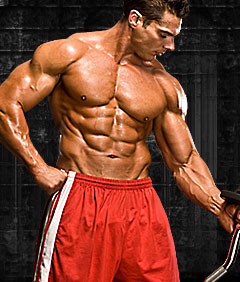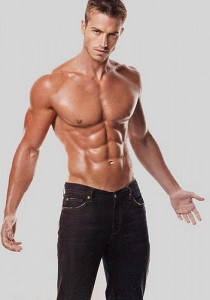In the ’80s, when they started appearing on everyone from Tom cruise to Madonna, muscular middles went mainstream. Hard cores were no longer hardcore. In Arnold Schwarzenegger’s era, some champs worked their abdominals for 30 minutes daily. For some of today’s pros, crunch time only comes precontest. This article is for nearly every bodybuilder, from gym novices to Mr. O competitors, because most of us are letting our abs off easy. In this article, we’ll examine the most frequent midsection mistakes and lay out ab solutions for making your center the center of attention.
#1 Ab neglect
 Bodybuilders might neglect abs because they assume they can chisel them in the next time they diet down. For them, the three Cs–carb restriction, cardio and crunches–go together like bacon, lettuce and tomato, and when their middles are not being defined, they figure, why bother? Another reason for neglect: even when bodybuilders do train abs, they tend to tack low-intensity sessions onto random workouts, and because those workouts accomplish little, they can be skipped with little guilt.
Bodybuilders might neglect abs because they assume they can chisel them in the next time they diet down. For them, the three Cs–carb restriction, cardio and crunches–go together like bacon, lettuce and tomato, and when their middles are not being defined, they figure, why bother? Another reason for neglect: even when bodybuilders do train abs, they tend to tack low-intensity sessions onto random workouts, and because those workouts accomplish little, they can be skipped with little guilt.
Just as there are two main reasons many bodybuilders neglect abs, there are two main reasons not to. First, core strength is necessary for key mass makers, such as deadlifts and squats. Second, you cannot maximize ab muscularity with a crash course. Instead, you need to grow–or at least maintain–these muscles year-round.
Solutions
- As with other muscles, set goals–from how you want your middle to look to specific rep and resistance targets.
- Twice per week, give your abs the same focus as other bodyparts. If you do cardio separately from your weight workouts, an excellent time to hit abs is before cardio, or you may want to ab up in a separate workout at home.
- Do eight to 12 sets for your rectus abdominis and three to five sets for your obliques.
- If you’re in a rush, superset abs with other bodyparts or do all your ab exercises as a giant set with no rest between exercises.
- To avoid the “Why bother?” blahs of endless crunches, infuse your ab workouts with intensity which brings us to our next mistake.
#2 Insufficient intensity

Pop quiz: What were your best sets last time you trained chest?
Now, answer the same question for abs. If you have a ready response about bench presses and inclines, but none for crunches and leg raises, give yourself an ab F. Rest assured, most bodybuilders fail this quiz. Not only do most of us train abs with insufficient intensity, but it seldom even occurs to us that we’re shortchanging our midsection workouts. Instead, we plod through sets of high reps, the sort we would never do for chest or any other bodypart.
Solutions
- Train to grow your abs, not tone them. The risk of overgrowing your rectus abdominis is akin to the risk of growing too rich–you should be so lucky. As with the woman who fears free weights will make her “look like a man,” alas, it’s never easy to alter ourselves. Train for growth. Toning will follow.
- Typically, do sets of 10-15 reps. When you can do more than 15, increase the resistance.
- Ab machines are often the most efficient way to add resistance.
- As opposed to increasing reps or the weight, you can boost intensity via techniques such as supersets and giant sets.
#3 Missing the target
Owing to their school-gym-period days of crunches and other calisthenics, many bodybuilders still spend more ab time working their hip flexors, straining their spinal erectors and rapidly flopping about than actually contracting their abs.
Solutions
- Do primarily crunching movements for the rectus abdominis, either free form or with a machine.
- Train at a slow, steady pace, focusing only on your abs.
- All ab exercises have short ranges of motion, and thus, contractions are paramount. Hold each contraction for one or two seconds and flex.
#4 Upper ab exclusivity
Most bodybuilders focus primarily, if not exclusively, on the upper rectus abdominis–the six-pack. In fact, that is only one of four ab areas to train. The other three are the lower rectus abdominis (from below your six-pack to your groin), the external obliques (on either side of your midsection) and the transverse abdominis (located underneath your rectus abdominis and obliques). The lower abs are often neglected, because–when you have at least some clothes on–they’re less visible than the upper abs. Obliques are typically skipped, because bodybuilders are afraid of widening their waists. Transverse abs are out of sight and, therefore, usually out of mind.
Solutions
- Lower abs are important for core strength and a powerful look that ties your upper and lower body together. Reverse crunches and leg or knee raises work this area.
- Obliques are also crucial for core strength, because they stabilize your upper body and, when fully developed and defined–picture the piano key rows on Dexter Jackson’s sides–they grab attention. Side crunches and machine trunk twists work this area. Waist width is primarily the result of a broad hip/waist structure. Nevertheless, if you’re concerned about oblique overgrowth, do sets of 20-30 reps.
- Your transverse abs aren’t visible, but they play a crucial role in your posture and keeping your belly in. You can work this area anytime and anywhere by pulling your bellybutton in toward your spine as far as possible and holding that position for a count of 10. Repeat for up to 10 times.
#5 Trying to train away fat
 Many bodybuilders think enough crunching will bring their abs into sharp relief. Although recent research proves spot reduction is possible, your best strategy for shedding adipose tissue and excavating your abs is a combination of dieting and cardio.
Many bodybuilders think enough crunching will bring their abs into sharp relief. Although recent research proves spot reduction is possible, your best strategy for shedding adipose tissue and excavating your abs is a combination of dieting and cardio.
Solutions
- Alter your diet to lose fat. Eliminate trans fat and minimize saturated fat and simple carbs. Focus instead on lean protein, complex carbs and healthy fats.
- Do 45-60 minutes of cardio postworkout or early in the morning.
- Focus your ab workouts on growth, and the new muscle will become increasingly more visible as you shed unwanted weight.
Lessons Learned
- Make time to train abs thoroughly twice per week.
- Keep most reps in the 10-15 range and focus on increasing reps or resistance. Boost intensity via supersets or giant sets.
- Train abs slowly, focusing on contractions.
- Work all four areas: upper abs, lower abs, obliques and inner abs.
- Diet and do cardio to lose fat; train abs to gain muscle.
Author: Greg Merritt, Senior Writer of Flex Magazine
References:
COPYRIGHT 2004 Weider Publications
COPYRIGHT 2008 Gale, Cengage Learning
Flex Magazine
www.findarticles.com
www.flexonline.com










